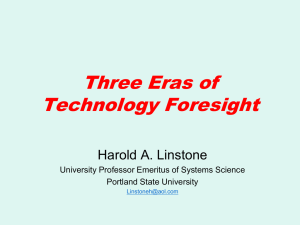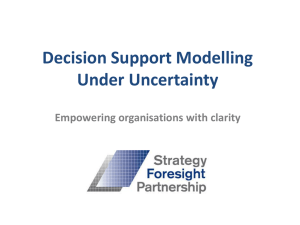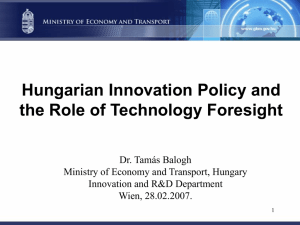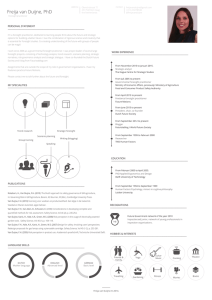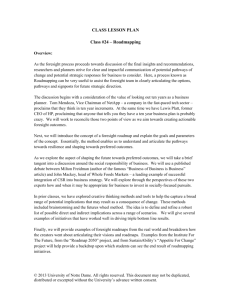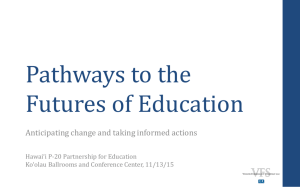The Future of Foresight 1.7 MB
advertisement
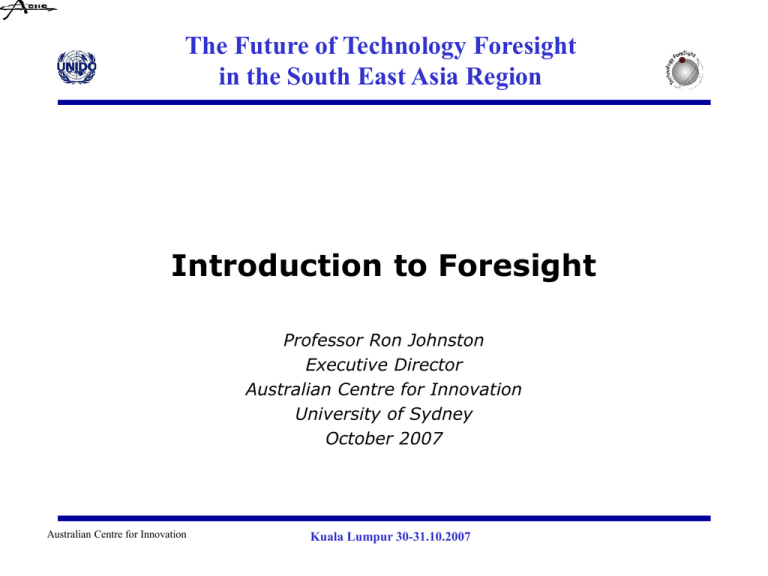
The Future of Technology Foresight in the South East Asia Region Introduction to Foresight Professor Ron Johnston Executive Director Australian Centre for Innovation University of Sydney October 2007 Australian Centre for Innovation Kuala Lumpur 30-31.10.2007 The Future of Technology Foresight in the South East Asia Region Why the Need for Foresight? Speed of change Complexity Uncertainty Shifting assumptions Mega-consequences Inter-connectedness Volume of available knowledge Australian Centre for Innovation Kuala Lumpur 30-31.10.2007 The Future of Technology Foresight in the South East Asia Region Different Views of the Future Extrapolative - tomorrow is decided by today Cyclic – things go around Evolutionary – things get better ‘Great Man’-driven – analyse the leaders Culturally determined – analyse values and beliefs Fatalistic – que sera sera Australian Centre for Innovation Kuala Lumpur 30-31.10.2007 The Future of Technology Foresight in the South East Asia Region Definitions of Foresight Foresight involves systematic attempts to look into the future of science, technology, society and the economy, and their interactions, in order to promote social, economic and environmental benefit. (APEC-CTF) Foresight is a process of anticipating and managing change. It is a systematic and participatory approach to developing effective strategies and policies for the medium- to longer term future. (APEC-CTF) Australian Centre for Innovation Kuala Lumpur 30-31.10.2007 The Future of Technology Foresight in the South East Asia Region Definitions of Foresight – 2 Foresight is a systematic, participatory, futureintelligence-gathering and medium-to-longterm vision-building process aimed at presentday decisions and mobilising joint actions. (IPTS - FORLEARN) Foresight is a means of systematically addressing the future, and acting on it. (R. Johnston) Australian Centre for Innovation Kuala Lumpur 30-31.10.2007 The Future of Technology Foresight in the South East Asia Region A process of systematic collective reasoning about the future Thinking the Future •involving the key stakeholders •Results are disseminated and discussed among a wide audience FORESIGHT Open Participatory Action oriented Debating the Future Australian Centre for Innovation not predicting a predetermined future but exploring how the future might evolve in different ways depending on the actions of various players and decisions taken ‘today’. Shaping the Future Not only analysing or contemplating future developments but supporting Kuala Lumpur 30-31.10.2007 actors in actively shaping the future The Future of Technology Foresight in the South East Asia Region Core Assumptions Future oriented thinking is vital for any forward planning, decision-making or policy development to meet future challenges Foresight enhances such thinking by gathering strategic anticipatory intelligence There are a variety of tools available to conduct foresight. Each has a different basis, different strengths and limitations, and different applicability. Foresight is most effective where it is directly linked to existing planning and decision-making tools which are addressing specific issues of the future. Australian Centre for Innovation Kuala Lumpur 30-31.10.2007 The Future of Technology Foresight in the South East Asia Region Objectives of Foresight Exercises Gathering intelligence on possible longer-term developments and how these may interact with the decisions made today Providing strategic visions and creating a shared sense of commitment to these visions among participants/stakeholders Building networks that bring together people from different sectors and institutions Providing alerts on major future risks and opportunities Australian Centre for Innovation Kuala Lumpur 30-31.10.2007 The Future of Technology Foresight in the South East Asia Region Fields of Application of Foresight Emerging technologies Research priorities Planning for industry sectors Natural resource management Business strategy Driving innovation into a supply-chain Regional economic development Education Australian Centre for Innovation Kuala Lumpur 30-31.10.2007 The Future of Technology Foresight in the South East Asia Region Some Recent Foresight Projects The Millennium Project of the American Council for the United Nations University Institute for Prospective Technological Studies (EU) Enlargement Project IPTS - detailed case studies of about 30 major foresight exercises in Europe Japanese National Institute for Science and Technology Policy 4-yearly report APEC Center for Technology Foresight (APEC-CTF) – Post-Genomics ASEAN Technology Foresight and Scan Project UNIDO - training programs in South America and Eastern Europe Foresight projects have also become embedded processes associated with emerging technologies. Australian Centre for Innovation Kuala Lumpur 30-31.10.2007 The Future of Technology Foresight in the South East Asia Region Methods of Foresight - 3 categories Expert opinion (Delphi) and scenario building emphasise human participation Modelling and morphological analysis emphasises the use of analytic tools, which are increasingly computer-based Scanning/monitoring and trend extrapolation emphasise the extent to which the future is determined by the conditions of the present Australian Centre for Innovation Kuala Lumpur 30-31.10.2007 The Future of Technology Foresight in the South East Asia Region Australian Centre for Innovation Kuala Lumpur 30-31.10.2007 The Future of Technology Foresight in the South East Asia Region Australian Centre for Innovation Kuala Lumpur 30-31.10.2007 The Future of Technology Foresight in the South East Asia Region Evolution of Foresight Emphasis – from methods to outcomes and policy Tool – from specialised to embedded - gradual adoption as a standard management tool Focus – from national to regional, sectoral, local and within organisations and communities Application – from priority-setting for public research to planning and decision-making, innovation, technology transfer Scope – from technological to socio-economic outcomes Scale - from ‘macro’ to ‘meso’ and ‘micro’ Increasingly IT-enabled Growth in foresight infrastructure capacity Australian Centre for Innovation Kuala Lumpur 30-31.10.2007 The Future of Technology Foresight in the South East Asia Region Lessons for Key Technology Identification through Foresight 1. In Western predominantly market economies (eg US, UK, Germany) identification of potential key technologies operates as a signal and information to which private sector corporations can respond. 2. In Eastern more planned economies (eg Japan, Korea) investment in research and technology development can be more explicitly steered through foresight studies. Australian Centre for Innovation Kuala Lumpur 30-31.10.2007 The Future of Technology Foresight in the South East Asia Region And there are plenty of resources to assist you: UNIDO Foresight Manual – unido.org AC-UNU State of the Future Reports – acunu.org FORLEARN - IPTS Foresight Training Manual – forlearn.jrc.es European Foresight Monitoring Network – a database of international foresight studies – efmn.info Australian Centre for Innovation Kuala Lumpur 30-31.10.2007
